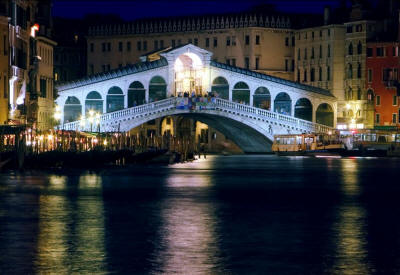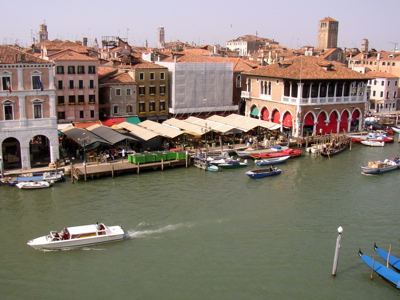Rialto: Difference between revisions
Sccrymsc5813 (talk | contribs) |
Sccrymsc5813 (talk | contribs) |
||
| Line 4: | Line 4: | ||
[[Image:Catanese_Rialto2.jpg|thumb|right|400px| The Rialto lit at night]] | [[Image:Catanese_Rialto2.jpg|thumb|right|400px| The Rialto lit at night]] | ||
== History of Bridges == | == History of Bridges == | ||
For centuries, Venice has been a central hub for shipping trade throughout the world because of the use of cargo ships. They travel through the multitude of canals which separate the 118 islands of Venice. Before the thirteenth century, the only way to cross the canals of Venice was to cross on wooden boards laid down in the canal connecting the two banks, and before that, pedestrians had to cross via a "bridge" of boats. Eventually, these wooden bridges would quickly wear down from the weight of the pedestrians and become highly unstable. The Rialto Bridge | For centuries, Venice has been a central hub for shipping trade throughout the world because of the use of cargo ships. They travel through the multitude of canals which separate the 118 islands of Venice. Before the thirteenth century, the only way to cross the canals of Venice was to cross on wooden boards laid down in the canal connecting the two banks, and before that, pedestrians had to cross via a "bridge" of boats. Eventually, these wooden bridges would quickly wear down from the weight of the pedestrians and become highly unstable. The Rialto Bridge was one of these wooden bridges until the 1580's. | ||
== Construction == | == Construction == | ||
Revision as of 04:16, 22 October 2013
The Ponte di Rialto (Rialto Bridge) is the oldest bridge in Venice that crosses over the Grand Canal. This bridge is the connection between the districts of San Polo and San Marco, and replaced a wooden bridge that contained a mobile center which allowed for ships crossing throughout the day. The current Rialto Bridge was made out of stone and was constructed between the years of 1588 and 1591 under the direction of Antonio de Ponte. The bridge is made of two inclined ramps on either end that come to a flat surface in the middle where pedestrians can gather and look out at the city from all angles.

History of Bridges
For centuries, Venice has been a central hub for shipping trade throughout the world because of the use of cargo ships. They travel through the multitude of canals which separate the 118 islands of Venice. Before the thirteenth century, the only way to cross the canals of Venice was to cross on wooden boards laid down in the canal connecting the two banks, and before that, pedestrians had to cross via a "bridge" of boats. Eventually, these wooden bridges would quickly wear down from the weight of the pedestrians and become highly unstable. The Rialto Bridge was one of these wooden bridges until the 1580's.
Construction
In the 1500’s, La Serenissima called upon architect Antonio Da Ponte to build a bridge that connected the two districts of San Polo and San Marco, after two famous architects at the time, Andrea Palladio and Vincenzo Scamozzi, made a bid for the contract of the bridge. Andrea Palladio and Vincenzo Scamozzi each wanted to build a bridge with three large arches with a kettle drum in the center that was supported by columns, but Antonio Da Ponte decided to create a structure similar to the previous wooden bridges crossing the Grand Canal. The structure of the old wooden bridges was formed by two ramps leading over the canal meeting at a portico.
Construction of the Rialto Bridge began in 1588 and proved to be a difficult task due to the depth of the sea bottom and other various conditions of instability. In 1591, three years after construction began, the bridge was finally finished, and has been standing ever since that moment.
For over two hundred and fifty years the Rialto Bridge remained the only way to cross the Grand Canal on foot, until the Ponte dell'Accademia, the Academic Bridge, was constructed in 1854. Since then, two other bridges have been constructed to cross the Grand Canal, Ponte degli Scalzi (Scalzi Bridge) and Ponte della Costituzione (Constitution Bridge). These four bridges allow pedestrians to cross from various points on the Grand Canal.
Present Day
Currently, the Rialto Bridge spans 23 meters wide, 29 meters long, and is situated over 7 meters above the Grand Canal. This bridge is a highly trafficked location within Venice, for both residents and tourists. There are a variety of restaurants within the area, most have outside eating facilities so that pedestrians can look out on the water and admire this grand structure. The area around the bridge also houses the Rialto Market. Every single day, hundreds of cargo ships bring fresh ingredients to this vast market, where thousands of people shop and purchase these items, which includes seafood, fruit, and vegetables.
